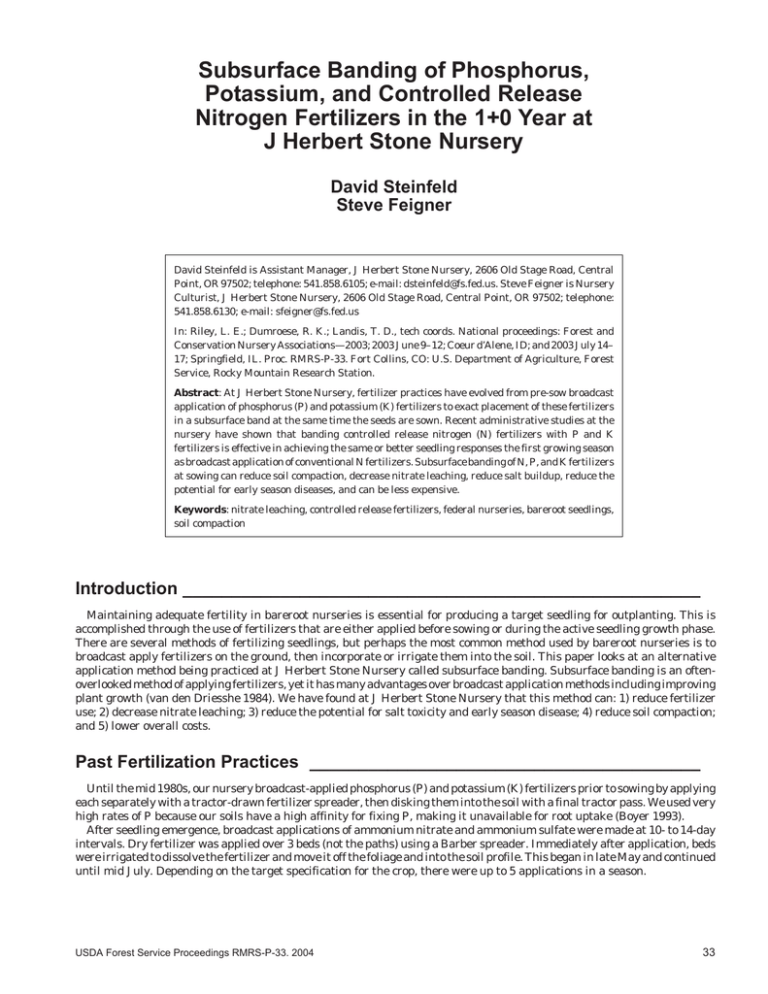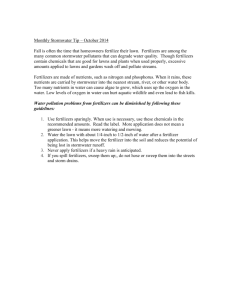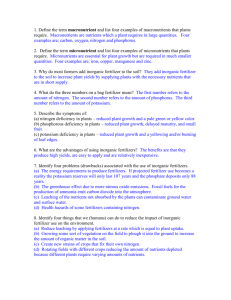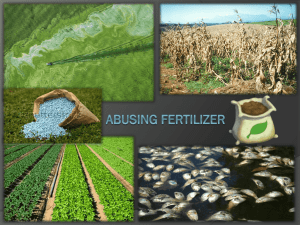Subsurface Banding of Phosphorus, Potassium, and Controlled Release
advertisement

Subsurface Banding of Phosphorus, Potassium, and Controlled Release Nitrogen Fertilizers in the 1+0 Year at J Herbert Stone Nursery David Steinfeld Steve Feigner David Steinfeld is Assistant Manager, J Herbert Stone Nursery, 2606 Old Stage Road, Central Point, OR 97502; telephone: 541.858.6105; e-mail: dsteinfeld@fs.fed.us. Steve Feigner is Nursery Culturist, J Herbert Stone Nursery, 2606 Old Stage Road, Central Point, OR 97502; telephone: 541.858.6130; e-mail: sfeigner@fs.fed.us In: Riley, L. E.; Dumroese, R. K.; Landis, T. D., tech coords. National proceedings: Forest and Conservation Nursery Associations—2003; 2003 June 9–12; Coeur d’Alene, ID; and 2003 July 14– 17; Springfield, IL. Proc. RMRS-P-33. Fort Collins, CO: U.S. Department of Agriculture, Forest Service, Rocky Mountain Research Station. Abstract: At J Herbert Stone Nursery, fertilizer practices have evolved from pre-sow broadcast application of phosphorus (P) and potassium (K) fertilizers to exact placement of these fertilizers in a subsurface band at the same time the seeds are sown. Recent administrative studies at the nursery have shown that banding controlled release nitrogen (N) fertilizers with P and K fertilizers is effective in achieving the same or better seedling responses the first growing season as broadcast application of conventional N fertilizers. Subsurface banding of N, P, and K fertilizers at sowing can reduce soil compaction, decrease nitrate leaching, reduce salt buildup, reduce the potential for early season diseases, and can be less expensive. Keywords: nitrate leaching, controlled release fertilizers, federal nurseries, bareroot seedlings, soil compaction Introduction _____________________________________________________ Maintaining adequate fertility in bareroot nurseries is essential for producing a target seedling for outplanting. This is accomplished through the use of fertilizers that are either applied before sowing or during the active seedling growth phase. There are several methods of fertilizing seedlings, but perhaps the most common method used by bareroot nurseries is to broadcast apply fertilizers on the ground, then incorporate or irrigate them into the soil. This paper looks at an alternative application method being practiced at J Herbert Stone Nursery called subsurface banding. Subsurface banding is an oftenoverlooked method of applying fertilizers, yet it has many advantages over broadcast application methods including improving plant growth (van den Driesshe 1984). We have found at J Herbert Stone Nursery that this method can: 1) reduce fertilizer use; 2) decrease nitrate leaching; 3) reduce the potential for salt toxicity and early season disease; 4) reduce soil compaction; and 5) lower overall costs. Past Fertilization Practices ________________________________________ Until the mid 1980s, our nursery broadcast-applied phosphorus (P) and potassium (K) fertilizers prior to sowing by applying each separately with a tractor-drawn fertilizer spreader, then disking them into the soil with a final tractor pass. We used very high rates of P because our soils have a high affinity for fixing P, making it unavailable for root uptake (Boyer 1993). After seedling emergence, broadcast applications of ammonium nitrate and ammonium sulfate were made at 10- to 14-day intervals. Dry fertilizer was applied over 3 beds (not the paths) using a Barber spreader. Immediately after application, beds were irrigated to dissolve the fertilizer and move it off the foliage and into the soil profile. This began in late May and continued until mid July. Depending on the target specification for the crop, there were up to 5 applications in a season. USDA Forest Service Proceedings RMRS-P-33. 2004 33 Steinfeld and Feigner Problems Associated With Broadcast Application __________ The spring months are often wet in southwestern Oregon. Excess moisture, coupled with our slow draining fields, results in the workability of our soils as less than optimum prior to sowing. The use of tractors for applying and disking P and K fertilizers will compact or puddle soils. Mitigating measures, such as deep ripping or subsoiling, have limited success under these conditions. The resulting effects of soil compaction on our crops can be devastating (Figure 1). In the compacted tractor paths created prior to sowing, seedlings have reduced root volumes and are often yellow and stunted. For our nursery, the best management practice is to limit the number of tractor passes over our fields when the soils are susceptible to compaction (Warkentin 1984). Applying nitrogen (N) fertilizers over the 1+0 crop in the early stages of seedling development is often a risk to seedling health. In the late spring and early summer, the climate at our nursery can turn hot. Average maximum air temperatures by late June exceed 85 ∞F (29 ∞C) and are often 10 to 20 ∞F (6 to 12 ∞C) hotter at the soil surface. This is a period when seedlings are small, succulent, and most susceptible to salt toxicity and damping-off diseases associated with broadcast application of N fertilizers. The higher surface salts associated with broadcasting N fertilizers can create moisture stress conditions in seedlings, especially where water distribution is uneven or durations of irrigation are not long enough to move fertilizers into the soil profile. In 1984, we experienced salt toxicity across our fields. That year the irrigation schedule for the 1+0 crop was a series of short bursts of water to the cool the surface of the soil when temperatures reached 90 ∞F (32 ∞C). With the high surface evaporation rates associated with the warm temperatures, fertilizer salts came to the soil surface through capillary action and were deposited there. Under these conditions the surface salt levels far exceeded the acceptable levels for seedling growth, and many seedlings either died or had very low vigor. We looked for solutions to this problem and found that seedbed mulching and periodic, Subsurface Banding of Phosphorus, Potassium, and Controlled Release Nitrogen... deep irrigations would move concentrated salts away from the soil surface and eliminate this problem. Nevertheless, we still occasionally experience this problem in some fields from year to year. High levels of surface N also increase the potential for damping-off diseases. At our nursery, damping-off occurs up until mid-July and often increases after we broadcast apply N fertilizers. The treatment is the same as with salt buildup— irrigate until the N and salts have moved sufficiently into the soil profile. The high rates of N used in broadcast fertilization, plus the need for longer irrigations to move salts and N into the soil profile, increase the potential for nitrate leaching into the ground water. Nitrate leaching is a long-term concern to Stone Nursery because we are located in an area where our neighbors depend on well water for domestic use. The area surrounding the nursery is becoming more and more residential with time. Subsurface Banding: An Alternative Method of Fertilizer Application ___ It should come as no surprise that our nursery started looking for alternatives to broadcasting P, K, and N fertilizers. In the mid 1980s, we began to apply P and K fertilizers with a bander at the same time we sowed seeds. We purchased a fertilizer bander from a local agricultural equipment dealer and then made a few modifications. The fertilizer bander came with a hopper that holds up to 900 lb (400 kg) fertilizer, a fertilizer metering system, and delivery tubes attached to knives that place the fertilizer at the desired soil depth. Over time we replaced the knives with rolling coulters from a Love-Öyjørd seed drill so there would be less soil disturbance. We also attached a hydraulically controlled metering system to ensure accurate fertilizer rates. Then we mounted the bander to the front of a LoveÖyjørd seed drill to obtain an exact placement of concentrated fertilizer in relation to the seeds (Figure 2). We adjusted the bander to place fertilizer 3 to 4 in (7.5 to 10 cm) deep and exactly between each seed row (Figure 3). The offset of fertilizer precisely between seed rows is important since it eliminates the potential of direct contact of fertilizer salts to the sensitive, developing root system. We have banded P and K fertilizers for over 15 years with good success and minor problems. Recently we considered the possibilities of subsurface banding controlled release N fertilizers and, in 2000 and 2001, we installed separate nursery fertilizer trials to test the effects of different rates of banded controlled release N fertilizers on seedling growth. The results, as will be discussed below, showed equal growth responses in one trial and significantly greater growth in another and gave us the assurance to try this operationally at the nursery. Benefits of Subsurface Banding ______________________ Figure 1—Lines of lighter colored seedlings caused by compaction associated with broadcast application P and K fertilizers prior to sowing. 34 The advantages of subsurface application of fertilizers in the 1+0 year at Stone Nursery are many and are summarized below. USDA Forest Service Proceedings RMRS-P-33. 2004 Subsurface Banding of Phosphorus, Potassium, and Controlled Release Nitrogen... Steinfeld and Feigner Less Trips, Less Soil Compaction By subsurface banding P and K fertilizers, we have significantly reduced the amount of soil compaction by eliminating 3 tractor trips prior to sowing. In turn this has also freed up tractors for other important spring work around the nursery. Less Fertilizer Needed Phosphorus and Potassium Fertilizer—When our nursery switched to banding P and K fertilizers, we reduced the amount of P and K fertilizers applied per acre by at least a third. Seedling growth and nutrient levels were not affected by the reduced rates. P and K fertilizers can be reduced because concentrated banded fertilizer has less soil contact. Since P and, to a lesser extent, K are fixed in the soil, less soil contact means more nutrients are available to the seedling around the banded fertilizer zone (Havlin and others 1999). Figure 2—Bander consists of fertilizer hopper (A), hydraulically controlled, chain-driven fertilizer meter (B), drop tubes (C), and coulters (D) that place fertilizer in the soil. Nitrogen Fertilizer—In recent years, fertilizer trials at Stone Nursery have shown that much smaller amounts of N in a controlled release fertilizer form are needed to achieve the same or better seedling growth responses when these fertilizers are subsurface banded. In 2000, we compared a polymer-encapsulated sulfur coated urea (35N:0P2O5:0K2O:18S with a 5 to 6 month longevity) at 2 rates (50 and 100 lb N/ac [57 and 113 kg N/ha) against our standard broadcast application of 141 lb N/ac (160 kg N/ha) (as ammonium nitrate and ammonium sulfate). Polymerencapsulated sulfur coated urea treatments were banded at sowing, while our standard N fertilizer was broadcast applied at approximately 10-day intervals between June and Figure 3—Fertilizers are placed between seed rows and at a depth of 3 to 4 in (7.5 to 10 cm) in the soil during sowing (A). Fertilizers are accessed by the root systems as seedlings develop (B). USDA Forest Service Proceedings RMRS-P-33. 2004 35 Steinfeld and Feigner Subsurface Banding of Phosphorus, Potassium, and Controlled Release Nitrogen... early July. The treatments were replicated 4 times in a randomized block design on 1+0 ship ponderosa pine seedlings. Seedlings were lifted the following winter and measured for height, stem diameter, root area, and shoot area. Results showed that seedlings from the controlled release fertilizer treatments at 50 and 100 lb/ac (57 and 113 kg/ha) rates were significantly taller (P = 0.10) than the standard nursery fertilization treatment (Table 1). Stem diameters were also significantly larger for the 100 lb/ac controlled release fertilizer treatment. The percent of seedlings with heights less than 6 in (15 cm) (considered a minimum height for some clients) were 41% for seedlings grown under standard fertilizer regimes as compared to 33% for the 50 lb/ac and 28% for the 100 lb/ac treatments. Foliar nutrient analysis showed very similar N values for all treatments. A similar controlled release banding trial installed the following year showed no difference between treatments. Less Potential for Salt Toxicity and Disease Newly emergent seedlings should have less exposure to salts and high N concentrations with banded controlled release fertilizers because it is placed between the seeds and below the surface of the soil (Figure 3). Even if irrigation patterns or scheduling were conducive to bringing salts to the soil surface, the salts would still have to move 3 to 4 in (8 to 10 cm) upward through the soil. Under these conditions, the concentrated salts would accumulate between the seedling rows and not around the seedling stem. Since controlled release N fertilizers are placed at a depth of 3 to 4 in (8 to 10 cm), N levels near the stem of the seedling are not as high as would be found under a broadcast fertilizer regime. Lower N levels should reduce the susceptibility of seedlings to damping-off diseases. Continuous N Feeding Controlled release fertilizers become available as soil temperatures increase. Because of the release nature of these fertilizers, N availability more closely coincides with the growth of the seedling. Instead of large inputs of N to the soil in a feast and famine schedule every 10 to 14 days with broadcast N fertilizers, controlled release fertilizers meter N continually during the growing season as soil temperatures increase. In contrast to broadcast applications that begin 6 weeks after seedling emergence, subsurface-banded fertilizers are available to the seedling soon after seedling emergence. Less Costs, More Flexibility Using controlled release fertilizers in bareroot operations seems uneconomical at first glance because of the higher product costs. Yet because 4 to 5 fertilizer applications are eliminated with banding and the amount of controlled release fertilizer purchased is less, the total banding fertilization program can be far less expensive. At Stone Nursery in 2003, these savings have offset the extra cost of purchasing controlled release fertilizer (Figure 4). The reduced amount of P and K fertilizers, the elimination of 3 tractor trips to apply and incorporate these fertilizers, and the switch from broadcast to banding N, P, and K fertilizers can result in a costs savings approaching 50%. Perhaps as important as savings, we have found that our equipment and personnel are freed up to do other critical work during that time of year. Less Nitrate Leaching A primary goal for changing fertilizer systems at Stone Nursery was to reduce the amount of nitrates potentially leaching into the ground water. The high solubility of conventional N fertilizers used in broadcast fertilization, the frequent fertilizer applications, and the longer irrigations increase the potential for nitrate leaching. By applying controlled release fertilizer, we are reducing the rate of N fertilizer use by at least a third, which correspondingly reduces the potential for nitrate leaching by a third. Disadvantages of Subsurface Banded Fertilizers ______________ Early experiences in banding P and K fertilizers impressed upon us the importance of placing fertilizers exactly between the seed rows. In the first years of banding, fertilizers were placed immediately below the seed row. We noticed in those years that some seedlings were either stunted or stressed in the early part of the growing season. Upon excavating these seedlings, we found that the developing taproots were hitting the banded fertilizer at 4 in (10 cm) and stopping because of the presence of high fertilizer salts. Table 1—Results from an administrative study comparing banded controlled release nitrogen fertilizers with broadcast applied fertilizers on a 1+0 ship ponderosa pine seedlot. Stem diameter Standard broadcast Banded controlled release Banded controlled release 141 lb N/ac (160 kg N/ha) 50 lb N/ac (57 kg N/ha) 100 lb N/ac (113 kg N/ac) Height mm cm 6.5a 6.5 a 6.6 b 15.2 a 16.7 b 17.1 b Seedlings culled <10 cm <12.5 cm <15 cm N Foliar nutrients P K - - - - - - - - - - - - - - - - - - percent - - - - - - - - - - - - - - - - - - - 9a 5a 4a 23 a 14 a 11 a 41 a 33 b 28 ab 2.42 2.31 2.46 0.24 .23 .23 0.78 .88 .88 Letter differences denote significant treatment differences at the 95% confidence level for percent seedlings culled and stem diameter and 90 percent confidence level for height. 36 USDA Forest Service Proceedings RMRS-P-33. 2004 Subsurface Banding of Phosphorus, Potassium, and Controlled Release Nitrogen... Steinfeld and Feigner Figure 4—Cost comparison of current fertilizer practices where all fertilizer is subsurface banded with past practices of broadcast applying fertilizers in the 1+0 year. While this did not kill seedlings, it significantly reduced first-year growth. This problem was easily corrected by placing the bander coulters between the seed rows. The presence of N in the late summer can affect seedling hardening. If controlled release fertilizers are still supplying N at this time of year, shutting down seedling growth could be difficult. Given the hot summer climate of our region, we don’t anticipate this will be a problem since seedling hardening can be induced by limiting the amount of irrigation or by wrenching the seedbed. If it does become a problem, we will reduce the amount of controlled release fertilizer that we use or switch to a fertilizer with a shorter release period. Using controlled release fertilizers requires that we become more aware of the seedling nutrient status and growth patterns. If a crop shows reduced growth rates or signs of nutrient deficiencies in the early season, we will have to supplement the controlled release fertilizers with one or more broadcast applications of conventional N fertilizers. The use of banded controlled release fertilizers will require more crop monitoring during the early stages of seedling development. Summary _____________________ first growing season is a cost effective alternative to broadcast application methods. Subsurface banding can reduce soil compaction, reduce fertilizer use, decrease nitrate leaching, decrease potential for salt toxicity and early season diseases, and be less expensive. Fertilizer banding equipment is available through local agricultural equipment suppliers and with some modification can be adapted to bareroot sowing equipment. References ____________________ Boyer D. 1993. Soil and Water Management Plan—J Herbert Stone Nursery [Unpublished document]. Central Point (OR): USDA Forest Service, J Herbert Stone Nursery. Havlin J, Beaton J, Tisdale S, Nelson W. 1999. Soil fertility and fertilizers – an introduction to nutrient management. Upper Saddle River (NJ): Prentice Hall. 499 p. van den Driesshe R 1984. Soil fertility in forest nurseries. In: Duryea ML, Landis TD, editors. Forest nursery manual: production of bareroot seedlings. Boston (MA): Martinus Nijhoff/Dr W Junk Publishers. p 63-74. Warkentin BP, 1984. Physical properties of forest-nursery soil: relation to seedling growth. In: Duryea ML, Landis TD, editors. Forest nursery manual: production of bareroot seedlings. Boston (MA): Martinus Nijhoff/Dr W Junk Publishers. p 53-62. At J Herbert Stone Nursery we have learned that subsurface banding P, K, and controlled release N fertilizers in the USDA Forest Service Proceedings RMRS-P-33. 2004 37






